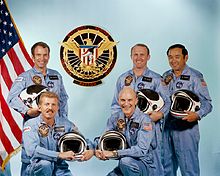STS-51-C
This article includes a list of references, related reading, or external links, but its sources remain unclear because it lacks inline citations. (May 2008) |
| COSPAR ID | 1985-010A |
|---|---|
| SATCAT no. | 15496 |
| End of mission | |

 | |
STS 51-C was the fifteenth flight of a space shuttle, the third flight of Space Shuttle Discovery, and the first United States Department of Defense mission. It conducted the fourth landing at Kennedy Space Center, Florida.
Crew
Number in parentheses indicates number of spaceflights by each individual prior to and including this mission.
- T. Kenneth Mattingly, II (3) - Commander
- Loren Shriver (1) - Pilot
- Ellison S. Onizuka (1) - Mission Specialist
- James Buchli (1) - Mission Specialist
- Gary Payton (1) - Payload Specialist
Backup crew
- Keith C. Wright - Payload Specialist
Mission parameters
- Mass:
- Payload: Magnum ELINT satellite ~ 3,000 kg
- Booster: IUS upper stage ~ 18,000 kg
- Perigee: 332 km
- Apogee: 341 km
- Inclination: 28.4°
- Period: 91.3 min
Mission highlights
First mission dedicated to Department of Defense. U.S. Air Force Inertial Upper Stage (IUS) booster deployed and met mission objectives. This mission's accomplishments are classified due to the nature of the work done. The shuttle deployed a single satellite, 1985-010B (USA-8).
According to Aviation Week & Space Technology, STS-51-C launched a secret, Magnum ELINT (ELectronic INTtelligence) gathering satellite into geosynchronous orbit. Identical satellites were also launched by STS-33 and STS-38.
Also according to Aviation Week, the shuttle initially entered a 204 km x 519 km orbit at an inclination of 28.45 deg to the equator. It then executed three OMS (orbital maneuvering system) burns, the last on orbit #4. The first burn is to circularize the orbit at 519 km.
The satellite was deployed on the 7th orbit and then ignited its IUS rocket at the ascending node of the 8th orbit, to place it in a geo-synchronous transfer orbit.
The classified payload was deployed successfully and boosted into its operating orbit by an Inertial Upper Stage (IUS) booster according to an Air Force announcement.
Connection to the Challenger Disaster
As a precursor to the Challenger's destruction almost exactly a year later, it was reported to the Rogers Commission that during the launch of STS-51-C, the worst solid rocket booster (SRB) blow-by effects of any mission prior to STS-51-L occurred, indicating conclusively that the viton O-Rings were not sufficiently sealing the hot gases inside the combustion chamber of the SRBs while firing. After they were recovered post-flight, the O-rings in both the right and left SRBs showed some degree of charring, but analysis of the center field joint of the right SRB showed an unprecedented penetration of the primary O-Ring and heavily charred effects on the secondary O-Ring.[1]
This is significant to the established consensus that cold air temperature was a major factor in Challenger's destruction because the temperature at STS-51-C's launch was also, up to its time, the coldest recorded at only 53 degrees Fahrenheit.[1]
Mission statement
Discovery was to make its third flight in January 1985 to conduct the first mission totally dedicated to the Department of Defense. The classified payload was deployed successfully and boosted into its operating orbit by an Inertial Upper Stage (IUS) booster according to an Air Force announcement.
The launch occurred on January 24, 1985, at 2:40 p.m. EST—the first of 9 Shuttle missions that year. It was originally scheduled for January 23, but was delayed because of freezing weather conditions. Challenger had been scheduled for this flight, but Discovery was substituted when thermal tile problems were encountered with Challenger.
The mission's duration was 3 days, 1 hour, and 33 minutes. Discovery touched down on Runway 15 at KSC on January 27 at 4:23 p.m. EST.
STS-51C marked the 100th human spaceflight to achieve orbit.
Notes
- ^ a b Rogers Commission Report (1986). "Report of the Presidential Commission on the Space Shuttle Challenger Accident, Volume 1, Chapter 6".
See also
- Space science
- Space shuttle
- List of space shuttle missions
- List of human spaceflights chronologically
External links

